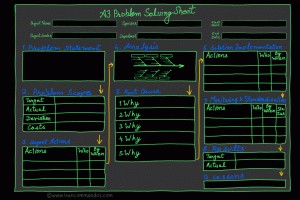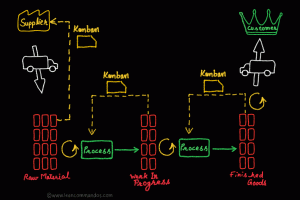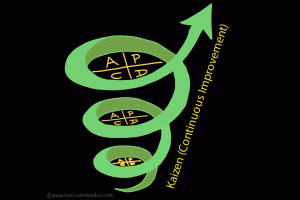Introduction
In the realm of Lean management, Takt Time stands as a critical measure that aligns production with customer demand. Derived from the German word ‘Takt,’ which means ‘beat’ or ‘meter,’ it fundamentally represents the rhythm or pulse at which products must be created to meet customer needs without accumulating excess inventory.
History and Development
The concept of Takt Time emerged from the need to improve manufacturing efficiency and has its roots in the automotive industry, notably within the Toyota Production System. It was developed to streamline production processes, eliminate waste, and ensure a steady flow of production to match the rate of customer demand.
Key Principles
Takt Time is underpinned by the principle of producing to demand, ensuring that production is closely tied to customer requirements. It balances workload, sets the pace for production, and provides a benchmark for measuring the effectiveness of the production process.
When to Use the Tool
Takt Time is most valuable in environments where customer demand is relatively stable, and the production process is repetitive. It is ideal for manufacturing settings where efficiency and waste reduction are primary objectives, and there’s a need for a consistent production pace.

How It Works
Implementing Takt Time involves a structured process designed to synchronize production with customer demand, thereby optimizing efficiency and minimizing waste. Let’s delve deeper into the intricacies of how Takt Time functions within manufacturing environments.
- Understanding Customer Demand: The journey begins with a comprehensive analysis of customer demand patterns. This entails gathering data on the number of units required over a specific timeframe, often a week or a month. Accurate forecasting and historical sales data play pivotal roles in this stage, providing insights into demand fluctuations and seasonal trends.
- Calculation of Takt Time: Once customer demand is determined, the next step involves calculating the Takt Time. This is achieved by dividing the total available production time by the customer demand for the corresponding period. The formula is straightforward: Takt Time = Available Production Time / Customer Demand. For instance, if the available production time is 40 hours per
- Monitoring Production Rate: Takt Time serves as a guiding principle for the pace of production. It establishes a rhythmic tempo, dictating how frequently units should be completed to meet customer requirements. Production rate is continuously monitored against the Takt Time benchmark. Any deviation, whether slower or faster, warrants immediate attention as it signifies potential inefficiencies or overproduction.
- Identifying Process Lag and Inefficiencies: Discrepancies between actual production rates and the prescribed Takt Time reveal critical insights into process performance. If production lags behind the Takt Time, it indicates inefficiencies or bottlenecks in the workflow that need to be addressed promptly. Conversely, if production surpasses the Takt Time, it signals a risk of overproduction, which can lead to excess inventory and associated costs.
- Achieving Continuous Flow: Takt Time implementation necessitates a holistic approach to streamline operations and achieve a seamless flow of production. This often involves reconfiguring workstations, optimizing workflows, and reallocating resources to synchronize processes with the prescribed tempo. By harmonizing production activities with Takt Time, organizations can minimize idle time, reduce cycle times, and enhance overall productivity.
- Continuous Improvement: Takt Time serves as a foundational element of continuous improvement initiatives within Lean management. Regular monitoring and adjustment of Takt Time in response to evolving customer demands and process improvements ensure ongoing optimization. Moreover, fostering a culture of Kaizen encourages employees to identify and address inefficiencies proactively, further enhancing operational effectiveness.
In summary, Takt Time operates as a dynamic framework that aligns production activities with customer demand, fostering efficiency, and waste reduction. By adhering to the rhythm set by Takt Time, organizations can optimize resource utilization, improve responsiveness to customer needs, and drive sustainable growth.
Benefits

Takt Time aligns production schedules with customer demands, reducing waste and improving efficiency. It enhances the predictability of production outputs and helps identify process bottlenecks. By standardizing work processes, it also aids in achieving consistent product quality.
Common Mistakes and Pitfalls
A common mistake in implementing Takt Time is not accounting for all variables that affect production time, such as machine maintenance and worker fatigue. Failing to regularly update Takt Time to reflect changes in customer demand can lead to inefficiencies. Overemphasis on pace without considering quality can also undermine the benefits of Takt Time.
Tips for Success
Regularly monitor and adjust Takt Time to ensure it reflects current demand. Engage all employees in understanding its importance. Balance the line so all processes can meet the Takt Time, and ensure quality is maintained throughout.
Integration With Other Lean Tools
Takt Time is often used alongside other Lean tools such as Kanban for inventory control, Andon for realtime monitoring, and Kaizen for continuous improvement. Together, these tools create a robust system for managing production efficiency.
FAQs
What is Takt Time?
Takt Time is the rate at which a finished product needs to be completed to meet customer demand.
How is Takt Time calculated?
Divide the available production time by the customer demand for that period to get Takt Time.
Can Takt Time change?
Yes, it should be recalculated when customer demand or available production time changes.
Why is Takt Time important?
It helps ensure that production is directly tied to customer demand, preventing overproduction and underproduction.
Is Takt Time suitable for every industry?
It is most effective in industries with steady customer demand and repetitive production processes.
References and Further Reading
- “The Toyota Way” by Jeffrey K. Liker
- “Lean Thinking: Banish Waste and Create Wealth in Your Corporation” by James P. Womack and Daniel T. Jones
- “Learning to See:Value Stream Mapping and Lean Thinking” by Mike Rother and John Shook
These books are highly regarded in the Lean community and offer in-depth knowledge on not just Takt Time, but various other Lean principles and tools. They serve as excellent resources for anyone looking to deepen their understanding of Lean practices.







3 Responses
Hey! I could have sworn I’ve been to this site before but after checking through some of the post I realized it’s new to me. Nonetheless, I’m definitely delighted I found it and I’ll be book-marking and checking back frequently!
Great, thanks for sharing this article post.Really thank you! Much obliged.
That is really interesting, You are an excessively professional blogger. I’ve joined your feed and look forward to in search of more of your great post. Additionally, I have shared your site in my social networks!